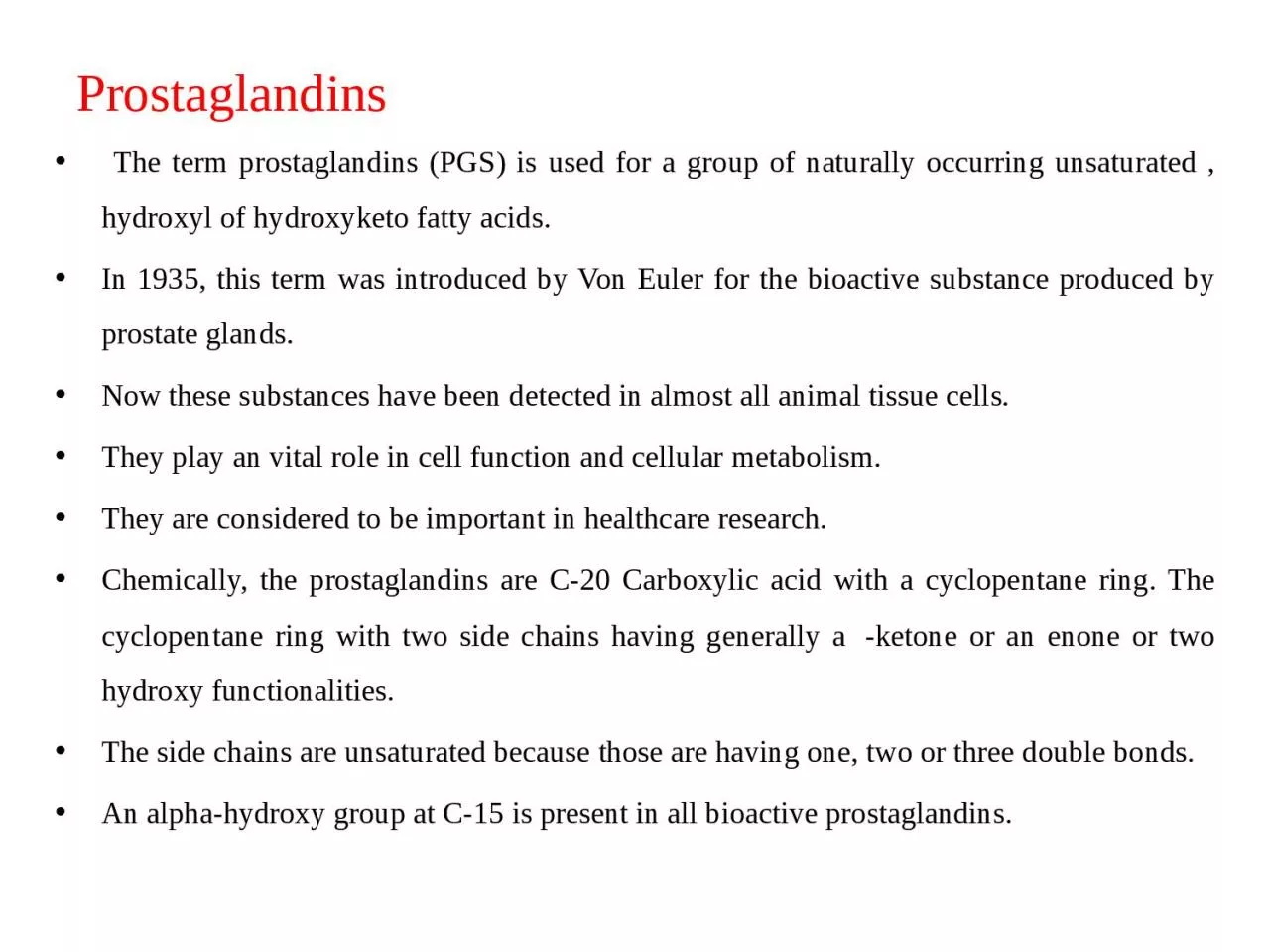

In 1935 this term was introduced by Von Euler for the bioactive substance produced by prostate glands Now these substances have been detected in almost all animal tissue cells They play an vital role in cell function and cellular metabolism ID: 1012331
Download Presentation The PPT/PDF document "Prostaglandins The term prostaglandins..." is the property of its rightful owner. Permission is granted to download and print the materials on this web site for personal, non-commercial use only, and to display it on your personal computer provided you do not modify the materials and that you retain all copyright notices contained in the materials. By downloading content from our website, you accept the terms of this agreement.
1. Prostaglandins The term prostaglandins (PGS) is used for a group of naturally occurring unsaturated , hydroxyl of hydroxyketo fatty acids.In 1935, this term was introduced by Von Euler for the bioactive substance produced by prostate glands.Now these substances have been detected in almost all animal tissue cells.They play an vital role in cell function and cellular metabolism.They are considered to be important in healthcare research.Chemically, the prostaglandins are C-20 Carboxylic acid with a cyclopentane ring. The cyclopentane ring with two side chains having generally a -ketone or an enone or two hydroxy functionalities.The side chains are unsaturated because those are having one, two or three double bonds.An alpha-hydroxy group at C-15 is present in all bioactive prostaglandins.
2. Structure
3. OCCURENCEFor the first time kurzrok and Lieb in 1930 reported the presence of prostaglandin in accessor genital glands.The richest source of prostaglandin is the human seminal plasma which is having up to 50-60 mg/ml.In 1935, gold blatt and Von Euler, who worked independently, reported that extracts from sheep vesicular glands and human seminal plasma exhibited similar effects on uterine smooth muscles . Later on, this study was extended to a variety of animals but only the sheep vesicular gland was having large amounts of Prostaglandins.
4. Dried homogenized glands from sheep +95% ethanolConcentrated, subjected to extraction, counter current distribution and reverse phase partition chromatographyAcidic solvent as eluent (PGF) 2 mg, small colourless needles .MP (102-103°c)Isolation
5.
6. Nomenclature and classification The parent skeleton of Prostaglandins is the fully saturated cyclopentane C-20 hydrocarbon known as prostate whereas the related carboxylic acid skeleton is known as prostanoic acid.ProstateProstonoic acid
7. The nomenclature of prostaglandins is based on the nature of the functionalities in 5 membered ring. On the basis of this prostaglandins are classified into several families PGA, PGB,PGC,PGD,PGE,PGF and PGH. The compounds with greater solubility in ether are called PGES, while the compounds with greater solubility in phosphate buffer are called (PGFS).PGAPGBPGC
8. In PGA and PGB letters A and B are used for compounds resulting from the reactions of PGE with acid and base respectively. PGDPGEPGFPGEPGAPGBH+_OH
9. Structures of some prostaglandins13,14-dihydroprostogladin (E2): In this prefix is dihydro whereas modified group is the saturation of carbon double bond.8-Azoprostogladin (E1): In this prefix is aza while the modified group is the replacement of methylene group with an Nitrogen atom.
10. 3) 11- Deoxy-11-Oxaprostoglandin (E1) : In this, the prefix is Oxa whereas the modified group is the replacement of methylene group with an oxygen atom.4) 19- Oxo prostaglandin (E1) : In this the prefix is Oxo while the modified group is the replacement of methylene group with a carbonyl group.
11. Ent-Prostaglandin (E1) : In this the suffix is the ent while the modified group is the reversa of all the chairal centres of a natural prostaglandin.6) Prostaglandin E1 methyl ester: In this suffix is carboxylic ester whereas the modified group is the esterification of acid group.
12. Biosynthesis of PGE2, PGF2 and PGD2 A microsomal enzyme system called Prostaglandin synthetase is widely distributed in mammalian tissues. This enzyme brings about the biosynthesis of prostaglandins from essential fatty acids such as arachidonic acid cascade. The prostaglandins are not stored in tissues but are biosynthesized and released demand by physiological stimuli.Arachidonic acid is precursor of PGE2 and PGF2 .This acid is stored as a phospholipids in tissues .
13. MetabolismMetabolite of PGE2Arachidonic Acid
14. EndoparoxidePGE2PGD2PGF2
15. Physiological role of prostaglandins They serve as local modulators of cell functions.They play a vital role in the regulation of endocrine, reproductive, nervous, digestive, haemostatic, respiratory, cardiovascular and renal functions.They control lipid and carbohydrate metabolismIf there occurs alternation in prostogladin production or metabolism, this may result in hypertension, bronchial asthama, pain, fever, inflammation and ulcer formation.
16.
17. is a blood vessel connecting the main pulmonary artery to the proximal descending aorta
18.
19.